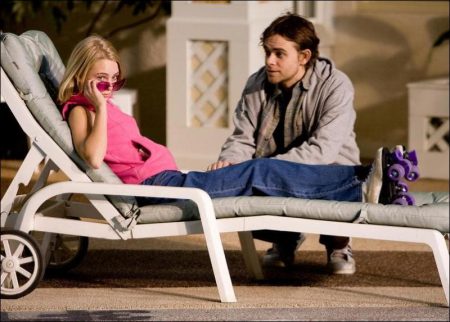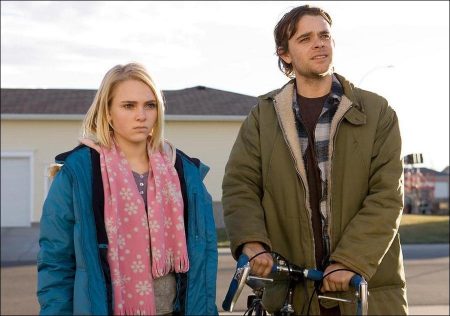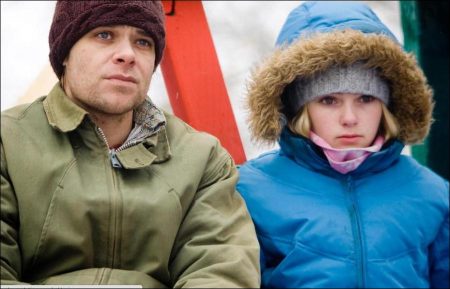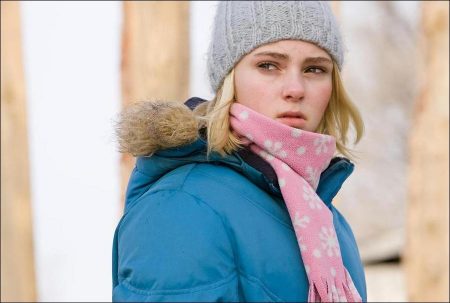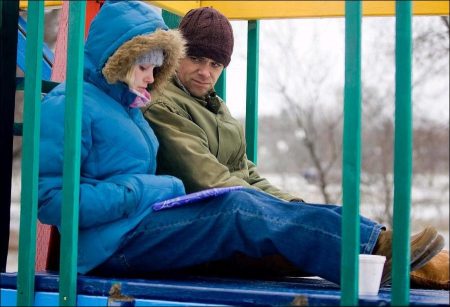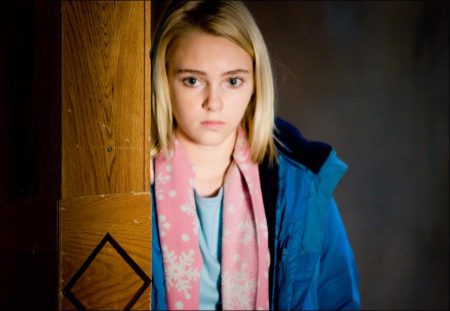Sleepwalking follows an 11-year-old girl’s struggle to come to terms with her mother’s abandonment. Joleen needs a place to stay so she turns to her younger brother, James. Joleen and her daughter, Tara, move in but soon after Joleen leads with another man. James tries to make his niece happy but things spin out of control, he loses his job and Tara is put into foster care. James decides to take off with Tara and try to make a better life for her.
Forced out of her home after her boyfriend is arrested, Joleen Reedy (Charlize Theron) needs a place to stay with her 11-year-old daughter, Tara (AnnaSophia Robb). She turns for help to her younger brother, James (Nick Stahl) — a simple and overly trusting man who doesn’t hesitate to welcome them into his modest rental apartment.
Almost as soon as she moves in, however, Joleen hits the road with another man. Utterly ill-equipped to be the sole guardian of an adolescent girl, James does his best to make his distraught niece happy. But before long, things spin out of control: he loses his road crew job and Tara is put into foster care.
Additionally, old wounds from his emotionally abusive and sometimes violent father (Dennis Hopper) begin to reopen as James is forced to re-examine his life. That’s when James makes a fateful decision that will bring his life full circle and force him to face his demons. He takes off with Tara and the pair assumes new identities as father and daughter. What starts out as a ploy to evade authorities takes on a deeper significance as James strives to become the dad Tara never had, and for the first time finds a true purpose in life.
All About Sleepwalking
After screenwriter Zac Stanford completed the first draft of his original screenplay Sleepwalking, he put it in a drawer and forgot about it. That was about six years ago. At the time, Stanford didn’t know anyone in the movie industry and despaired of ever getting the script produced. “I wrote it for the pure pleasure of writing it because I just love writing and for some reason I wanted to tell the story,” he says. “But when you finish writing, you realize you have no chance in hell of getting this made. You’re just crushed by the uphill task ahead of you.”
But when another of Stanford’s scripts generated interest in Hollywood, he met William Maher, who would go on to make his directorial debut with Sleepwalking. Maher had been working in visual effects for a number of years, with credits on such blockbusters as X-Men, Lethal Weapon 4 and Mars Attacks, and was stretching his creative wings by trying to develop projects of his own. When he met Stanford, the two formed a friendship and realized they shared similar tastes in films and stories. “One day, Zac produced this script that he’d kept hidden in a drawer for years and he said, ‘Take a read of that,’” Maher recalls. “That was the genesis for me.”
Maher still remembers the powerful impact Sleepwalking had on him when he read it for the first time. “It was one of the most honest pieces of writing I’d ever come across,” he says. “It was brutally honest. It hurt in all the right places. It was funny in all the right places. It had a blend of characters that fired off each other brilliantly. It was like gold. You just read it and you go, ‘This is really pure.’ And that’s a very rare thing. From the moment Zac handed it to me I knew I wouldn’t let this thing go until it was made.”
Stanford based the script in part on memories from his own past. “I know about these characters from growing up in a more rural area,” he explains. The experience of fatherhood was also a major impetus for the story, though not in any autobiographical sense: “I wrote this when my daughter was a toddler and it probably is an expression of a feeling that I felt very poignantly at that time, which is, why don’t we take care of our kids? How is it that people actually don’t take care of their kids? Nick Stahl’s character, James, is the person least able to take care of a child, and the person least able to be responsible, and yet he does it.”
The filmmakers knew from the start that getting Sleepwalking made would be difficult, in part because the material is far from typical Hollywood fare. Enter Academy Award® winning actress and producer Charlize Theron, who played the pivotal role in getting Sleepwalking to the screen. “My initial reaction to the script was that it was powerful, unusual and original,” the actress says. “I was moved to tears when I read it. It spoke loudly to something I haven’t really seen in film—the idea that we can own our own lives. That we don’t have to live in the darkness or the shadow, or be haunted in any way by our legacy or by our family. Just because we have the same blood flowing in our veins, we don’t have to make the same mistakes.”
With Theron on board, the difficulties the filmmakers had encountered getting the project off the ground began to dissolve. While moving into the new production offices of her company, Denver and Delilah Films, Theron had a chance meeting with one of her neighbors, WJS Productions president and co-founder A.J. Dix. She urged Dix to read the script, and shortly thereafter found WJS Productions to be a willing partner in the project. “I already knew that Charlize was a woman of great taste,” says Dix. “We read the script right away and loved it. It was unusual, and it hit all the right heartstrings for me..”
The combination of Theron’s cachet among fellow actors and friends in the industry and the quality of the script eventually attracted what Maher calls a “little cyclone of talent,” including such acclaimed, big name actors as Woody Harrelson and Dennis Hopper. “It became this thing that started to attract people because they understood why it was being made,” Maher says. “There was just something about it that was interesting.”
All told, Stanford says about five years elapsed from the time he closed the drawer on the first draft of the script to the time shooting began in October 2006. That gave the filmmakers a lot of time to think about how to approach the project. While the extra time didn’t eliminate that many surprises it did have its benefits. “I had a lot of preparation done, and I think that gave me a sense of confidence in the material,” Maher says. “So all of those things came into play as soon as I got a chance to make the film.”
“When I sat down with him at the start of the film, he explained to me in very great detail what his vision was,” says producer Rob Merilees. “He also brought about an hour’s worth of visuals to show me on video. It blew me away. Bill had been thinking about this film for years and years, and had everything mapped out in his mind.”
Theron concurs: “He spent so much time with this material, he knew it inside and out, and there really wasn’t anything he hadn’t thought about. That’s what you want from your director.”
For his part, Maher says the skills of the cast and crew took a lot of pressure off him. For instance, seeing the work of cinematographer Juan Ruiz Anchía was immediately reassuring. “When I started to see what he was doing with the dailies that was a pretty extraordinary thing, because we were sitting around going, ‘Wait a second, this is our film. Wow, this looks good!’” Maher recalls. “So that meant I could just focus all of my time with the actors, which is great.”
About The Location
Sleepwalking’s story is divided roughly into three sections, each of which takes place in a different environment. The first part of the film is set in James’ hometown in Northern California; the second is the road trip James and Tara take as they flee the authorities and the third takes place on the Utah farm where James spent his childhood. The multiple locations combined with the production’s shoestring budget and tight 29-day shooting schedule presented the filmmakers with some unique challenges.
To get the highest production values for their money, the filmmakers traveled to Regina in the Western Canadian province of Saskatchewan, north of Montana, to shoot the film. Once shooting began in October 2006, cast and crew braved sub-zero temperatures and more than one blizzard. “It was brutal,” says Maher of the shoot, adding that the filmmakers endured their share of ribbing from the hardy local crew for having come from sunny California.
Producer Rob Merilees recalls that the first day of shooting was the coldest, at minus 35 degrees with wind chill to boot. “Everybody was turning to me and going, ‘What a jerk! You brought us here. It’s your fault,’” he laughs.
Making matters more difficult was the speed with which everyone had to work, given the tight schedule and the fact that some actors had very limited availability. Hopper had to cram two weeks’ work into six day periods in order to meet another obligation; Harrelson did all his scenes in just two days.
Getting actors to fly to such a remote place to work for scale for such short periods was a further testament to their commitment to the project, Theron says. “When you have absolutely no money and you’re dragging people all the way out into Regina, which is a place that nobody’s ever heard of, it’s asking a lot of somebody,” she says. “I think we realized how lucky we were to get the cast that we did.”
Challenges aside, both filmmakers and actors agree Saskatchewan’s landscape helped establish the right mood and tone for the piece. “When we came here and started location scouting, it was unbelievable what we found,” says Theron. “So many of the locations felt like they were especially built for our story. We didn’t have to compromise at all, especially when it came to the Reedy farm. We had seen so many farms, and when Bill and I saw it, we just lost it and were like two little kids jumping up and down.”
“I think Regina brings a very special quality to the film,” says AnnaSophia Robb. “When I first got to the farm, it was exactly how I had envisioned it when I read the story. It was cold and desolate, but it’s also beautiful at the same time. You can look at it in two different ways, which relates to the characters as well.”
“The location’s just great,” Hopper says. “I was born in Dodge City, Kansas, and I was raised on a wheat farm, so this is very much like the kind of country that I was raised in.”
Cinematographer Juan Ruiz Anchía says he got lucky with the weather, which ranged from extremes of cloudy, sunny, rainy and mostly snowy. That worked perfectly with the filmmakers’ plan to have the movie progress from a more cheerful, colorful look in the beginning to a colder, greyer look in the final act to reflect the rising drama. “Somehow we started shooting the ending first and it was snowing, it was overcast and bad weather,” Anchía recalls. “And when we shot the beginning of the story at the end of the shoot, it was sunnier.”
Sleepwalking (2008)
Directed by: William Maher
Starring: Nick Stahl, AnnaSophia Robb, Charlize Theron, Deborra-Lee Furness, Woody Harrelson, Dennis Hopper, Mathew St. Patrick, Callum Keith Rennie, George Grassick, Troy Skog, Lori Ann Kennedy
Screenplay by: Zac Stanford
Production Design by: Paki Smith
Cinematography by: Juan Ruiz Anchía
Film Editing by: Deena Charara
Costume Design by: Cathy McComb
Set Dekorasyonu Sara Longfellow
Art Direction by: Sara McCudden
Music by: Christopher Young
MPAA Rating: R for Language and a scene of violence.
Studio: Overture Films
Release Date: March 14, 2008
Views: 82
